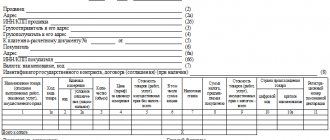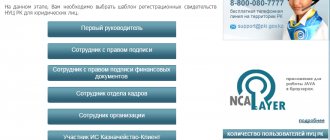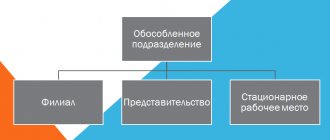Total cost of equipment including VAT 65,150.00 Including VAT 18% 9,938.14 2. Delivery time: within 25 calendar days from the date of signing this specification. 3. Terms of delivery: Delivery of products is carried out by road at the expense of the Supplier at the address: Moscow, st. Montazhnaya, 1 4. Consignee: Orion LLC, Moscow, st. Montazhnaya, 1 5. This Specification is drawn up in two copies having equal legal force, one copy for each of the parties. 6. This Specification comes into force from the moment it is signed by both Parties and is an integral part of the Agreement.
Delivery agreement: consignee and payer are different
Civil Code of the Russian Federation. In the absence of such a document, we can talk about unjust enrichment on the part of the consignee and failure to fulfill obligations to supply goods on the part of the supplier. This means that the consignee will be forced to return the goods to the sender and contact his supplier under the contract with a demand for a new delivery. Drawing up shipping documentation A separate problem when such complex legal relationships arise is the correct preparation of shipping documentation, which is necessary so that the buyer has the opportunity to fulfill your obligations to pay for the goods in accordance with the terms of the contract and to the proper person. The procedure for filling out commodity and transport documentation in legal relations in which the supplier and the shipper are not the same person is established by paragraph.
What information does the column contain?
The invoice form itself and the rules regarding the procedure for filling it out were approved by Resolution No. 1137, issued by the Government of the Russian Federation in 2011. Section I of this regulatory act is devoted specifically to the invoice. He indicates that the document must contain a number of information, starting from the date of preparation and number, ending with the identifier of the government contract (if the invoice is used in the field of government procurement).
Specifically about the sender and recipient of the cargo, the document indicates the following information:
- Name indicating the form (JSC, LLC, etc.) for organizations, name - for individual entrepreneurs.
- Legal address of the organization.
- TIN and checkpoint. If the organization is a tax agent (for example, it is a separate division of the checkpoint) (clause 2 of Article 161 of the Tax Code of the Russian Federation), then a dash is placed in the column instead of the data.
IMPORTANT: In 2020, the procedure for indicating the address has undergone changes!
Previously, this column was filled out in accordance with the Charter for a legal entity. Now it is filled out according to the Unified State Register of Legal Entities (or according to the Unified State Register of Entrepreneurs for individual entrepreneurs). This means that now the address must be indicated in detail: if the Charter allows only the indication of a locality, then complete data is entered into the Register - right down to the office number.
Consignee in the supply agreement
Attention
By signing this agreement, the Buyer confirms that this agreement is not an interested party transaction or a major transaction for him. The person who signed this agreement has all the necessary and sufficient powers to conclude and sign this agreement, internal documents of the Buyer; the person who signed this agreement is in no way limited in signing and concluding this agreement, and there are no other obstacles or restrictions for concluding and signing this agreement on the part of the Buyer. Appendix No. 1 to the Product (Goods) Supply Agreement No. dated " " 2020.
Specification No. 1 from " " 2020 1. Name, quantity and price per unit of the Goods to be supplied: No. Name Quantity, pcs.
Secure invoice details
There are a number of safe details that will not entail a refusal by the tax office to deduct VAT:
| Additional details | You can include additional information in the document, for example: product number, price list number; |
| Units | It is necessary to indicate only if the product can be measured in any units; |
| Document Number | You can number invoices, as it is convenient for the organization; |
Is it necessary to indicate the consignee in the consignment note according to TORG-12?
Price including VAT, rub. Cost including VAT, rub. Not accepted by the supplier. The products (batch of products) are considered accepted by the Buyer according to the qualitative and quantitative characteristics specified in the accompanying documents. 5. Responsibility of the parties 5.1. The claim procedure for resolving disagreements that have arisen between the parties is mandatory. The party that received the claim is obliged to respond to it within 10 (Ten) days from the date of its receipt.
5.2. All disputes arising from non-fulfillment of the contract and not settled by agreement of the parties are considered in the Arbitration Court in accordance with current legislation. 5.3. Relations between the parties not provided for in this agreement are regulated in accordance with the current legislation of the Russian Federation. 5.4. The Buyer has no right to transfer to third parties its rights and obligations under this agreement without the written consent of the Supplier 5.5.
Clause in the contract consignee another organization
In addition, in practice, the supplier and the shipper are often not the same person. In this case, the following questions are legitimate: how in such a situation should the relationship of the parties be formalized and to whom should claims be made in the event of failure of any of the participants to fulfill their obligations. Supply contract in the case where the buyers and consignee are not the same person. Conditions for the procedure for supply and delivery of goods are presented in Art. Art. 509 - 510 Civil Code of the Russian Federation. In accordance with paragraph 1 of Art. 509 of the Civil Code of the Russian Federation, the supply of goods is carried out by the supplier by shipping (transferring) the goods to the buyer, who is a party to the supply agreement, or to the person specified in the agreement as the recipient.
In the second case, the contract provides only general conditions, according to which the buyer will subsequently provide the supplier with shipping orders. In particular, the contract in this case must contain instructions on the content and duration of the order provided by the buyer. In addition, the contract must also secure the buyer’s right to send such orders to the supplier. The buyer himself is obliged to pay for the received goods to the supplier, even in the case when the goods are actually delivered to another recipient, and even in the case when the recipient is directly named in the supply agreement (Resolution Presidium of the Supreme Arbitration Court of the Russian Federation dated March 6, 2001 N 8853/99). Supply contract in the case where the suppliers and the shipper are not the same person. In accordance with clause.
1 tbsp. 510 of the Civil Code of the Russian Federation, delivery of goods must be carried out only by the supplier.
Financial newspaper”, 2008, N 16 PARTIES OF LEGAL RELATIONS IN DELIVERY: SUPPLIER, BUYER, SHIPPERS, CONSIGNEES The conclusion of a supply agreement is a widespread transaction in economic transactions. At the same time, contractual legal relations in this case may not develop in a completely standard way: for example, organizations that are not parties to the contract may participate in the delivery and receipt of cargo. The parties to the supply contract are defined by Art. 506 of the Civil Code of the Russian Federation, where the supplier-seller and the buyer are named as such. In fact, the contract may provide that the cargo should be delivered not directly to the buyer, but to the consignee specified by him.
If the Buyer determines that the received products do not comply with the quantity or quality, the latter is obliged to immediately notify the Supplier about this. The fact of non-conformity of the received products in terms of quantity and quality must be documented in accordance with the established procedure, and the presence of a representative of the Supplier is mandatory. If the Supplier refuses to have a representative arrive, the report must be drawn up in the presence of a representative of an independent organization. 4.4. If the discrepancy in quantity and quality of the received products is due to the fault of the Supplier, the Buyer has the right to demand that the Supplier replace low-quality products or make up for the missing quantity of products within 30 (Thirty) days from the date of receipt by the Buyer of the products, provided there are supporting documents. 4.5. If the Buyer fails to comply with the conditions of clauses 4.2., 4.3., 4.4.
Important
The terms of the contract also stipulate that acceptance of the goods by the consignee from the supplier means simultaneous acceptance of the goods by the consignee from the buyer. In this situation, should the consignee's representative, in order to receive the goods from the supplier's warehouse, submit a power of attorney to receive the goods and who should draw up and issue this power of attorney? A Russian organization, as a supplier, has entered into a supply agreement, the parties to which are the buyer and the consignee. All parties to this supply agreement are legal entities; they are named in its preamble, as well as in the section where the details and signatures of the parties are indicated.
Info
This agreement is valid from the moment of its signing until December 31, 2017. The expiration of the agreement does not relieve the parties from fulfilling their obligations under this agreement. 6. Change and termination of the agreement 6.1. Changes and additions to the agreement are carried out by agreement of the parties and are formalized by an additional agreement in writing and signed by both parties.
Copies of documents transmitted by fax have legal force until the originals are transmitted. 6.2. The contract is considered terminated if, before its expiration, neither party declares (in writing) its extension. 7. Force majeure 7.1. If force majeure circumstances occur (military actions, natural disasters, etc.), the agreement is suspended for the entire period of existence of these circumstances.
7.2. The supply agreement stipulates that the goods are transported by the consignee at the expense of the consignee. The consignee undertakes to remove the goods from the supplier's warehouse within 5 working days from the date of receipt by both the buyer and the consignee of a written notification from the supplier about the readiness of the goods for shipment from the supplier's warehouse. The date of shipment of the goods to the buyer is the date of the supplier's mark on the goods transport or invoice about the shipment of goods from supplier's warehouse (for shipment by road) or the date of the stamp at the shipper's station on the railway invoice (for shipment of goods by rail). The delivery date of the goods is the date of shipment of the goods from the supplier's warehouse.
Consignment note (sample and rules for filling out the consignment note)
Question:
The company sells goods on conditions where payment for the goods is made not by the buyer, but by a third party. The consignment note (form No. TORG-12) contains the column “Payer”. Which organization should be indicated in this column in this case?
Answer:
Indeed, the standard form of the invoice does not allow it to reflect the content of a business transaction when the buyer and payer under the sales contract are two different persons: it contains the line “Payer” and does not have the column “Buyer”. We believe that the standard form of the consignment note is also focused on the standard conditions of the sales contract, when the buyer himself undertakes to pay for the goods (Article 454 of the Civil Code of the Russian Federation).
At the same time, civil legislation allows for two schemes for constructing contractual relations, in which payment for goods to the supplier is made not by the buyer himself, but by a third party:
a) payment for the goods under the terms of the contract is the responsibility of the buyer, but the buyer entrusts the fulfillment of this obligation to a third party as a method of fulfilling this obligation (in accordance with Article 313 of the Civil Code of the Russian Federation);
b) payment for the goods under the terms of the contract is, in principle, the responsibility of a third party. The basis for the application of this contract structure is clauses 2 and 3 of Art. 421, paragraph 1, art. 308 of the Civil Code of the Russian Federation).
When using any of these structures, it should be taken into account that in accordance with the Resolution of the State Statistics Committee of the Russian Federation dated December 25, 1998 No. 132 “On approval of unified forms of primary accounting documentation for the accounting of trade operations,” the consignment note (form No. TORG-12) is drawn up in two copies , serves as the basis for writing off and capitalizing material assets.
That is
— the invoice, in principle, is not the basis for payment for the goods;
- its second copy must go to the person acquiring ownership of the goods, that is, the buyer.
Therefore, in the “Payer” column of the delivery note, the buyer of the goods should be indicated.
The basis for payment for goods, as a general rule, is an invoice. However, issuing an invoice for the delivered goods will only be important in the second described contract structure.
How to fill out the lines correctly?
If it concerns the shipper. According to the rules established by the current edition of Resolution No. 1137, the lines relating to the shipper are filled in as follows:
The full name is indicated, but an abbreviation is also allowed.
- The address is indicated according to the Unified State Register of Legal Entities.
- If he and the seller are one person, then, according to paragraphs. “e” clause 1 of section I of the resolution, in the corresponding line you can write “he”. If the sender of the goods is not the seller, but another person, the mail address of the shipper is indicated. Finally, if the invoice is issued under an agreement relating not to goods, but to services or work, nothing is written on the line - a dash is placed.
- If the document is issued by an agent acting on his own behalf, but purchasing goods from two or more sellers, in the line “Consignor” all of them are indicated, but separated by a semicolon.
Now about situations when we fill out lines about the consignee. Resolution No. 1137 for the consignee establishes similar standards:
- The name is indicated - full or abbreviated.
- The address according to the Register is indicated.
- If the invoice is for services, a dash is placed in the column concerning the recipient of the cargo. The wording “aka” is not provided for by the resolution.
- If there are two or more consignees, the names and addresses of each are indicated separated by a semicolon.
Registration of trade-12 and TTN
In the first case, the buyer himself sends the order to pay for the goods to the supplier to a third party, and the third party pays on his behalf and for the buyer, as indicated in the payment instructions in the payment document.
Thus, in the second method of drawing up an agreement, according to which payment for goods is, in principle, the responsibility of a third party, we recommend that you issue a delivery note to the buyer (which is indicated in the “Payer” column) and an invoice to a third party. In this case, the delivery note contains lines for specifying attachments. We recommend that you indicate the invoice in them so that the documents can be identified with each other.
At the same time, please note that the Procedure for using unified forms of primary documentation (approved by Resolution of the State Statistics Committee of the Russian Federation dated March 24, 1999 No. 20) allows additional details to be provided in standard forms of primary documents. In accordance with this, both the payer for the goods and the buyer can be indicated in the delivery note.
Invoice new in 2020
- A column “Identifier of government contract, agreement (agreement)” has appeared in the header - this field must be filled in if data is available;
- A “product type code” has appeared in the tabular section - it must be filled out if the document is sent to Belarus, Armenia, Kazakhstan or Kyrgyzstan;
- The word “registration” was added to the customs declaration column
- The field for signature of an individual entrepreneur has been supplemented with the words “or other authorized person”; now, with a power of attorney, he can sign a document representing the interests of the individual entrepreneur;










